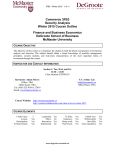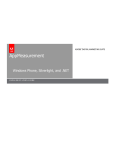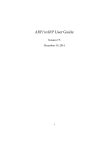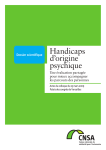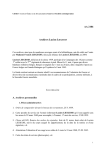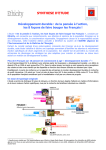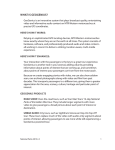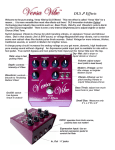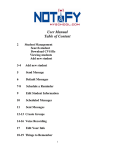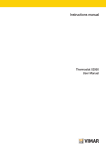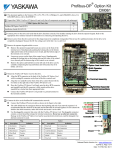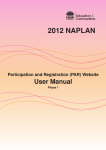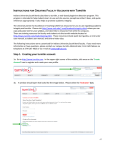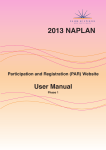Download Course Outline Template
Transcript
3FB3 – Fall 2013 - Page 1 of 9 Commerce 3FB3 Security Analysis Fall 2013 Course Outline Finance and Business Economics DeGroote School of Business McMaster University COURSE OBJECTIVE The objective of this course is to introduce the student to both the theory and practice of investment analysis and selection. The student should obtain a broad knowledge of security markets and riskreturn characteristics of the more important forms of investment through this course. INSTRUCTOR AND CONTACT INFORMATION Section 1 Day: Mon, Wed, and Thu 16:30 – 17:20 Class Location: CNH/102 Keith MacInnes, CFA, CGMA, CPA.CMA, CPA/PFS (Delaware) Instructor [email protected] Office: DSB/313 Office Hours: Monday: 3:00-4:00 p.m.; Tuesday 1:00-2:00 p.m. and 5:306:30 p.m.; and Friday 9:00-10:00 p.m.; and by appointment Tel: (905) 525-9140, Ext. 23397 (as office is shared by number of instructors, please do not leave messages) Cell: (416) 917-6440 COURSE ELEMENTS Credit Value: Avenue: Participation: Evidence-based: 3 Yes Yes Yes Leadership: Ethics: Innovation: Experiential: Yes No Yes No IT skills: Numeracy: Group work: Final exam: Yes Yes Yes Yes Global view: Written skills: Oral skills: Guest speaker(s) Yes Yes Yes No 3FB3 – Fall 2013 - Page 2 of 9 COURSE DESCRIPTION The course begins with an overview of the structure of financial markets in Canada and in the United States, followed by a more in-depth analysis of key investment topics. These topics include asset allocation and portfolio management, assessment of portfolio performance, the capital asset pricing model, term structure of interest rates, valuation of stocks and bonds, capital market efficiency, and behavioural finance. This course serves as a useful introduction to the Chartered Financial Analyst (CFA) curriculum (http://www.cfainstitute.org.). LEARNING OUTCOMES Upon completion of this course, students should: Have a good understanding of various financial assets; Have a good understanding of the functioning of security markets; and More importantly, be able to think logically and systematically. REQUIRED COURSE MATERIALS AND READINGS Avenue registration for course content, readings, and case materials http://avenue.mcmaster.ca. Investments: Seventh Canadian Edition, by Z. Bodie, A. Kane, A.J. Marcus, S. Perrakis, P.J. Ryan; McGraw-Hill Ryerson, 2011. A Texas Instruments BA II Plus financial calculator is recommended and will be used in class. However, any calculator that performs time value of money functions is acceptable. EVALUATION A combination of lectures, discussion and problem solving. Students will be encouraged to think, analyze, evaluate, and problem-solve, not memorize. Students are expected to come to class on time and be prepared for the class, i.e., to have read the assigned reading and to have done the assigned problems. Your final grade will be calculated as follows: Components and Weights Class Contribution Investment Challenge And Group Report Mid-term Exam Final Exam TOTAL 5% 20 30 45 100% NOTE: The use of a financial calculator is allowed during examinations in this course. 3FB3 – Fall 2013 - Page 3 of 9 Investment Challenge (20%) Ten percent based on your group’s ending portfolio value compared to the other groups’ ending portfolio values and ten percent based on the Group Report. There should be three students in a group for the project. The Investment Challenge is offered in the GTF Trading room. We will use Thomson-Reuters Eikon to obtain real-time financial information and the Financial Trading System software to facilitate trading and performance tracking. The intent is to provide students the opportunity to gain hands-on experience in trading and portfolio management. The objective of the trading is a specific combination of maximizing your portfolio value. Your beginning investment capital is USD $1,000,000. Trading starts at the open of the Toronto Stock Exchange on Monday, September 23, 2013, and continues until the close of the Toronto Stock Exchange on Friday, November 22, 2013. Trading is limited to the securities included in the “McMasters Combined Case” which includes a good selection of large US and Canadian stocks, Currency, Commodities, Index Options and Futures, and ETFs. TRADING FACILITIES 1. Each student has an individual trading account as well as a group trading account. Trades through the individual account are for practice only and have no bearing on evaluation. 2. You can log into FTS at the IDC as well as the GTF. You must use either your group or your individual username and password and with these can only access the McMasters Combined Case. 3. The Eikon user manual is available at each terminal at the IDC or the GTF. To access it login into “virtual desktop” using your Mac ID. 4. You should save your settings on a USB memory stick upon completing a session at the IDC. 5. You can trade at home, in principle, but you will not have access to information and real time quotes from Eikon, cannot be sure of your trade price in advance, and information will be delayed by 15 minutes. 6. To trade at home you must download and install: http://www.ftsmodules.com/public/modules/ftssystemmanager/setupSystemManager.htm In the middle left of the FTS System Manager, select from the dropdown box: “FTS Real Time Client 4.0.0.4” after you select this, you will see the Real Time Instructions on the right side. You must keep the student application box checked. In the FTS Real Time Client window, select “McMasters Combine Case” from the drop down box. Enter Trading Name and Password and click "Login". 3FB3 – Fall 2013 - Page 4 of 9 TRADING RULES Students should analyze available economic, financial and corporate data and make portfolio investment decisions using the latest information. A. Trading begins on Monday, September 23, 2013 and continues until Friday, November 22, 2013. B. The objective of the trading is to maximize your ending portfolio value. C. Your beginning investment capital is USD $1,000,000. D. You could buy and short bonds, futures, mutual funds, options, and stocks traded in the United States and Canada. Minimum stock price for buying is $0.25. Minimum stock price for shorting is $3. E. Interest will be earned on all available cash balances and credited at the close of each day. Interest will be calculated using a money market rate. F. A brokerage commission is applied to all transactions. The commission for most trades made on the web page is a flat $10. G. For margin trading, the margin requirement is 50% and interest is charged on daily basis. H. The maximum position for each individual security is $250,000. No day trade (i.e. buying and selling of the same security in the same day) is allowed. I. After the first two weeks, not more than 10% of your portfolio should be put in cash or near cash securities (e.g. T-Bills). This 10% near cash restriction is relaxed in the first two weeks of trading. Use asset allocation to achieve your diversification objective. J. At the end of the trading simulation, you should have invested in bonds, futures, mutual funds, options, and stocks. GROUP REPORT In the group report, you are expected to: 1. Provide a detailed description of your investment strategy, based upon the goal of maximizing your portfolio value. 2. Explain how you executed your investment strategy. 3. Discuss the risk characteristics of your investment strategy. 4. Evaluate your track record using standard portfolio performance measures. The length of your report must not exceed 12 pages, double-spaced, and including all graphs, tables and references. Your group report is due at the beginning of the Final Exam. Exams The Midterm and Final Exams are closed book. You will be able to use one note sheet, 8.5 * 11 inches for both the Midterm and Final Exam. You may use the back and the front of the note sheet. You will be responsible for preparing it on your own. Students are allowed to have whatever they want on their note sheet. The note sheet does NOT have to be handwritten. The Midterm Exam is 2 hours long and the Final Exam is 2 ½ hours long. Students must pass the combination of the midterm and final exam in order to pass the course. 3FB3 – Fall 2013 - Page 5 of 9 Class Contribution Your contribution is essential component in the overall education process. Contribution takes place in many forms: asking informed questions in class, making intelligent comments, reading the case and being prepared to discuss the issues, actively listening to your peers and working with others. Please remember that quantity is no substitute for quality. There will be ample opportunity to contribute to the class. The format of the in-class discussions of cases may take a variety of forms including: group analysis of single case issues during class, presentation of issues and leading discussions of the case issues. It is your responsibility to ensure that you take an active role in class. If this is a problem for you, I urge you to talk to me to discuss ways that you can make a contribution. The grading for the class contribution in each class is as follows: Grade 0 1 2 Contribution Does not show up for class. Attends class but says very little. Makes a significant contribution to the class by making important points with a significant element of originality or demonstrating mastery of difficult theoretical issues or concepts; is always prepared having read and analyzed prior to class, the various aspects of the problems and issues involved, shares in class presentations, contributes to in-class group work. Conversion At the end of the course your overall percentage grade will be converted to your letter grade in accordance with the following conversion scheme. LETTER GRADE A+ A A- PERCENT 90 - 100 85 - 89 80 - 84 B+ B B- 75 - 79 70 - 74 65 – 69 LETTER GRADE C+ C CF PERCENT 60 - 64 55 - 59 50 - 54 0 - 49 Communication and Feedback Students who are uncomfortable in directly approaching an instructor regarding a course concern may send a confidential email to the respective Area Chair ([email protected]) or the Associate Dean ([email protected]). Students who wish to correspond with instructors or TAs directly via email must send messages that originate from their official McMaster University email account. This protects the confidentiality and sensitivity of information as well as confirms the identity of the student. Emails regarding course issues should NOT be sent to the Area Administrative Assistants. 3FB3 – Fall 2013 - Page 6 of 9 Instructors are required to provide evaluation feedback for at least 10% of the final grade to students prior to Week #8 in the term. Instructors may conduct an informal course review with students by Week #4 to allow time for modifications in curriculum delivery. Students who wish to have a course component re-evaluated must complete the following form: http://www.mcmaster.ca/policy/Students-AcademicStudies/Form_A.pdf In order for the component to be re-read: the component must be worth 10% or more of the final grade in the course students pay a fee of $50 in Gilmour Hall #209 (receipt is then brought to APO) the Area Chair will seek out an independent adjudicator to re-grade the component an adjustment to the grade for the component will be made if a grade change of three points or greater on the 12 point scale (equivalent to 10 marks out of 100) has been suggested by the adjudicator as assigned by the Area Chair if a grade change is made, the student fee will be refunded ACADEMIC DISHONESTY It is the student’s responsibility to understand what constitutes academic dishonesty. Please refer to the University Senate Academic Integrity Policy at the following URL: http://www.mcmaster.ca/policy/Students-AcademicStudies/AcademicIntegrity.pdf This policy describes the responsibilities, procedures, and guidelines for students and faculty should a case of academic dishonesty arise. Academic dishonesty is defined as to knowingly act or fail to act in a way that results or could result in unearned academic credit or advantage. Please refer to the policy for a list of examples. The policy also provides faculty with procedures to follow in cases of academic dishonesty as well as general guidelines for penalties. For further information related to the policy, please refer to the Office of Academic Integrity at: http://www.mcmaster.ca/academicintegrity REQUESTING RELIEF FOR MISSED ACADEMIC WORK 1. Students may request relief from a regularly scheduled midterm, test, assignment or other course component in the following two ways: a) b) for absences from classes lasting up to five (5) days; or for absences from classes lasting more than five (5) days. a) For absences from classes lasting up to five (5) days 3FB3 – Fall 2013 - Page 7 of 9 Students must use the MSAF (McMaster Student Absence Form). This is an on-line, self-reporting tool, for which submission of medical or other types of supporting documentation is normally not required. Students may use this tool to submit a maximum of one (1) request for relief of missed academic work per term as long as the weighting of the component is worth 29% of the final grade or less. Students must follow up with their course instructors regarding the nature of the relief within two days of submitting the form. Failure to do so may negate the opportunity for relief. It is the prerogative of the instructor of the course to determine the appropriate relief for missed term work in his/her course. If the value of the component is worth 30% or more, students must report to the APO to discuss their situation and will be required to provide appropriate supporting documentation. b) For absences from classes lasting more than five (5) days Students cannot use the MSAF. They MUST report to the APO to discuss their situation and will be required to provide appropriate supporting documentation. Students who wish to submit more than one request for relief of missed academic work per term cannot use the MSAF. They must report to the APO and discuss their situation with an academic advisor. They will be required to provide supporting documentation and meet with the Director. The MSAF cannot be used during any final examination period. Students unable to write a mid-term at the posted exam time due to the following reasons: religious; work-related (for part-time students only); representing university at an academic or varsity athletic event; conflicts between two overlapping scheduled mid-term exams; or other extenuating circumstances, have the option of applying for special exam arrangements. Please see the DeGroote Missed Course Work Policy for a list of conflicts that qualify for academic accommodation http://ug.degroote.mcmaster.ca/forms-and-resources/missed-course-work-policy/ Such requests must be made to the Academic Programs Office at least ten (10) working days before the scheduled exam along with acceptable documentation. Instructors cannot themselves allow students to unofficially write make-up exams/tests. Adjudication of the request must be handled by the Academic Programs Office. If a mid-term exam is missed without a valid reason, students will receive a grade of zero (0) for that component. STUDENT ACCESSIBILITY SERVICES Student Accessibility Services (SAS) offers various support services for students with disabilities. Students are required to inform SAS of accommodation needs for course work at the outset of term. Students must forward a copy of such SAS accommodation to the instructor normally, within the first three (3) weeks of classes by setting up an appointment with the instructor. If a student with a disability chooses NOT to take advantage of an SAS accommodation and chooses to sit for a regular exam, a petition for relief may not be filed after the examination is complete. The SAS website is: http://sas.mcmaster.ca 3FB3 – Fall 2013 - Page 8 of 9 POTENTIAL MODIFICATIONS TO THE COURSE The instructor and university reserve the right to modify elements of the course during the term. The university may change the dates and deadlines for any or all courses in extreme circumstances. If either type of modification becomes necessary, reasonable notice and communication with the students will be given with explanation and the opportunity to comment on changes. It is the responsibility of the student to check their McMaster email and course websites weekly during the term and to note any changes. COURSE EVALUATION A course evaluation will be conducted near the end of the term. Students are asked to participate in this evaluation. 3FB3 – Fall 2013 - Page 9 of 9 COURSE SCHEDULE Commerce 3FB3 Security Analysis Fall 2013 Course Schedule Date Chapter Topic September 5,9,11, and 12 1 2 Introduction The Investment Environment Markets and Instruments September 16,18, and 19 3 Trading on Securities Markets 4 5 Portfolio Theory Risk and Return: Analyzing the Historical Record Risk Aversion and Capital Allocation to Risky Assets 6 Optimal Risky Portfolios 7 8 Equilibrium in Capital Markets: The Capital Asset Pricing Model Index Models and the Arbitrage Pricing Theory Thanksgiving September 23,25,and 26 September 30 and October 2, and 3 October 7,9, and 10 October 14 9 October 16 and 17 20 October 21,23, and 24 15 Friday, October 25 October 28 and 30 12 October 31 Market Efficiency Active Portfolio Management: Active Management and Performance Measurement Equities Security Analysis Midterm(TO BE CONFIRMED) Fixed-Income Securities Bond Prices and Yields Mid-term Recess November 4,6, and 7 13 The Term Structure of Interest Rates November 11,13 and 14 12 Managing Bond Portfolios November 18,20 and 21 17 Derivatives: Options and Other Derivatives: Introduction 18 Option Valuation 19 Futures, Forwards, and Swap Markets November 25,27, and 28 December 2 and 4 December 6 - 20 Final Exam (Investment Challenge Group Report Due)









